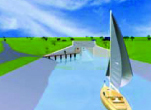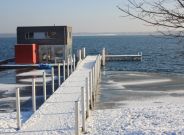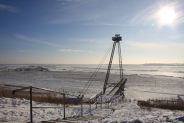Newsletter from 02/15/2010Internationale Bauausstellung (IBA) |
|||||
(1) IBA Lusatia 2010:"The Workshop for New Landscapes" presents its projectsThe IBA Fürst-Pückler-Land has launched 30 multi-stranded projects since the year 2000 on the transformation of structures and landscapes in the old Lusatian lignite mining district, Europe's largest landscape reconstruction site. It has shown in international discourse and with regional partners what kind of future there can be for relics of the industrial past, how a lakeland emerging from flooded open-cast mines can attain a unique character, how post-mining landscapes have the potential to develop into scenic natural landscapes, innovative energy landscapes or new man-made landscapes, and how "transitional landscapes" in mining regions can be made into tourist attractions. Federal President Horst Köhler left an important message when he visited the IBA Terraces back in 2005 that "there are ideas here, there is a future here". IBA Director Rolf Kuhn echoed this sentiment, saying, "The wheels of change will keep on turning even when the IBA has gone. The creative process and the developments will not come to a dead stop. The IBA has made its contribution to the region, coming alongside the landscape redevelopment process with expert guidance and acting as a driving force in terms of planning and developing networks. It has carried a new positive image of Lusatia into the world, and its legacy consists mainly in the projects it has realised but also in the plans it has laid down for the time when the IBA has left". In its presentation year of 2010 visitors from near and far will have the opportunity to see the achievements for themselves and to discover all the IBA projects through a variety of events and tours. |
|||||

(2) In process:Ground-breaking ceremonies, installations and openings in 2010The IBA pilot area of Großräschen has undergone immense changes in the last decade. Today the "Seestraße", which literally translates as "lake road" no longer leads to a grey "hole" but to a lake which is already one-fifth full. The "Seehotel Großräschen" lakeside hotel is opening a second guest house here in April. According to the Lausitzer und Mitteldeutsche Bergbau-Verwaltungsgesellschaft, the ground-breaking for the canal between Lake Ilse and its neighbour Lake Sedlitz is scheduled to follow in the second half of the year. The statement on funding taken by the federal state for the twelve million euro project has allegedly gone to the Zweckverband Lausitzer Seenland-Brandenburg. The 186-metre-long underground canal will cross four railway tracks and the main B 169 road. The building work for the ambitious project is scheduled to be completed in 2013. Mayor of Senftenberg Andreas Fredrich has also announced that building is scheduled to start in the course of the year on Senftenberg town harbour, the features of which took shape last year through the IBA competition and the winning design. Plans are also on the table for the installation of the 160-metre-long footbridge on Lake Sedlitz. The eight floating pontoons measuring 20 metres in length were transported from the BUGA Horticultural Show in Schwerin to the Lusatian Lakeland before the end of last year. The approval and planning phase should be finished in the spring and the work completed by the beginning of the summer. Visitors to the Lakeland will then be able to walk on the largest lake in Brandenburg and imagine the appeal behind this aim of the IBA to have a 1000-metre floating footbridge over the lake. |
|||||

(3) Hop over to Lusatia:Programme for IBA FinaleOn 24 April on the IBA Terraces the Finale will be inaugurated by Minister-President Matthias Platzeck and framed by the "Paradise 2" art project. The statewide cycle rally event "Brandenburg radelt an" will see cyclists setting out from Cottbus, Lübben, Finsterwalde and Senftenberg and converging on Großräschen. All visitors know is that a spectacular arena in the former open-cast mine and a Lusatian Symphony awaits them when they get there. This will be followed by the opening of the exhibition "The Reconquering of a Landscape" and exciting open-cast mine tours. Swiss artist and director of Paradise 2 Jürg Montalta is promising the region an exceptional programme of events until October which will "get under the skin". He has stage-managed a total of seven events with 21 performance dates. The landscape will form the impressive backdrop and the people of Lusatia will be the performers on his stage. In addition to the IBA Terraces, the settings include the open-cast pit and mining town of Welzow, the village of Schlabendorf with the Sielmann nature reserve, Plessa power station, the ruins of the parish church in the divided town of Guben-Gubin on the river Neisse, the Gelsenkirchner Allee in the Cottbus district of Sachsendorf-Madlow, and Lake Sedlitz in the Lusatian Lakeland. There will also be various events organised by partners of the IBA projects. Eleven exciting themed tours will run on foot, by bus, bicycle, jeep or raft from the planet "Mars" to industrial giants, newly emerging lakes and to IBA projects. The detailed guide and programme will be published in time for the International Tourism Exchange trade show in Berlin on 10 March. |
|||||
|
|
|||||

(4) "Paradise 2" art project:More than 1,000 Lusatians already involvedSwiss artist and theatre director Jürg Montalta has managed to inspire the Lusatians with enthusiasm for his art project. Preparations for his artistic productions are in full swing and regular rehearsals are taking place. There are already more than 1,000 people altogether who are involved in the project. The 'Paradise' location in Schlabendorf near Luckau was recently the venue for an assembly lasting several days attended by British composer Hazel Leach and 130 contributors, some of them Greek musicians. They are working together on a village music composition. "The more we internalise the lyrics and melody which Hazel Leach has composed on the basis of our stories and the history of our 800-year-old village, the more we feel transported back to that era", said Schlabendorf resident Lilo Niepraschk. By contrast, the "listening circles" in the divided town of Guben-Gubin on the river Neisse have come to an end this week. Germans and Poles met regularly at these events to listen to each other's stories. The ruins of the parish church were the central focus. German and Polish organists are now using these stories as a basis for an arrangement for a 24-hour organ recital which is to be performed in the ruins on 8 May. People from Großräschen and numerous choirs from the region are rehearsing for the Lusatian Symphony which will be held in the open-cast mine for the prelude to the IBA Finale. And one lake further up the people of Sedlitz are busy preparing the spectacular sound & light sculpture. |
|||||
(5) In workFuture scenarios for the Welzow post-mining-landscapeThe kick-off workshop for a Welzow master plan took place yesterday as part of the EU project "ReSOURCE" and saw many local key players and partners discussing their ideas of a vision for the future of the post-mining landscape and economy on the basis of three development scenarios. The different concepts are "Welzow Wilderness - Raw Nature", "Welzow Adventure - Tourism and Leisure" and "Welzow Energy Land" with the focus on renewable sources of energy. International trends in landscape development will form a starting point, as will local ideas and proposals. "Things went well at the first meeting of the multi-disciplinary project team", said IBA project manager Brigitte Scholz, "there was a broad range of input on the various scenarios". The participants were keen for existing approaches to be consolidated and for new ideas to be incorporated in the existing framework. Once the themes of all three scenarios have been unpacked, there would ultimately have to be an integrated mix of all three. The next workshop will be held on 31 March. The results will eventually be fed into a study which is a major building block in the ReSOURCE project. Master plans are also being drawn up for the mining regions of Sokolov-East in the Czech Republic and Zasavje in Slovenia and the emerging region of Chemnitz-Zwickau. |
|||||

(6) Living on the water:Survey on floating architectureThe IBA has been looking into the subject of floating architecture for some years. IBA partners have also been fired up with enthusiasm for this idea and the three buildings which have now been floating on the new Lusatian lakes since 2006 include a holiday home, a diving school and a residential house and are likely to be welcoming further additions this year. Plans are also on the table for a floating discovery centre on the F60. "The floating architecture has become part of the regional development concept for the Lusatian Lakeland", said IBA project coordinator Michael Feiler, "and we want to promote this development of offshore architecture." An online survey is currently being conducted on the subject which is intended to find out how much interest there is in floating architecture and which aspects are important to those who are interested. Follow this link to take part in the survey. |
|||||

(7) Winter wonderland of Lusatia:Well worth a visit to the IBA TerracesThere are still a few weeks to go before the start of the season on the IBA Terraces on 20 March but it is well worth a visit now. The view over the white open-cast mining landscape is awe-inspiring and the tour team is taking inquiries and advance bookings for trips to the changing white landscape. Furthermore, the "IBA meets IBA" exhibition is still on until 7 March. It summarises the 100-year history of International Building Exhibitions in Germany and is a good source of information about their aims and projects. Admission is free. |
|||||
last update: 1/26/2017 13:13 |
|||||
